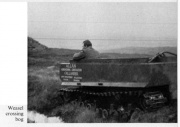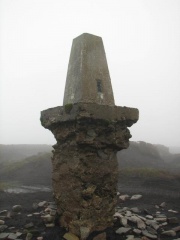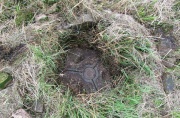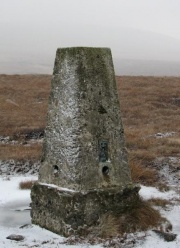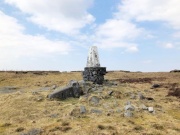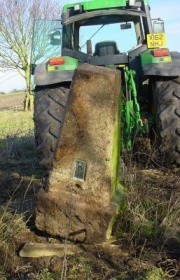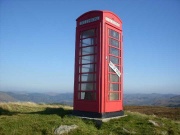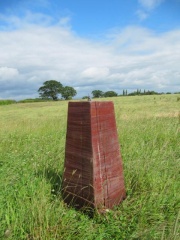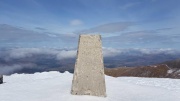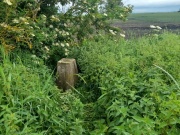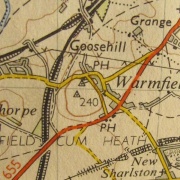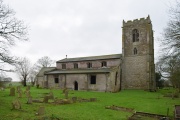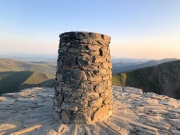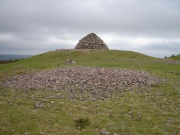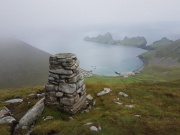Unusual trigpoints
Some out of the ordinary trigs...
| Animal Aggro
The OSGB36 record for the trig pillar at Nippets reports that it was vandalised by rabbits. It appears to have survived the attack. The OS record for the trig at Beacon Hill Pillbox reports "H&S hazard (Dobermans) Owner unhelpful". At one time, there was a chance of spotting a wallaby at The Roaches but they haven't been seen in recent years. Likewise the [in]famous goats of Ben Vrackie are no longer reported. Visitors fortunate enough to reach the trig at Knowsley Park might spot a Rhino - hopefully from a safe distance. At least one dog is registered on T:UK whilst a polished FB is a sign of a visit by sheep or cattle, probably more interested in using the pillar as a scratching post than in logging a visit. |
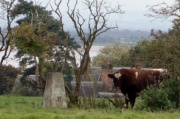 trig defender photo © Painterman61 |
| Weaselly reached
In the mid-1950s, the OS used an ex-US Army vehicle known as a 'weasel' to transport materials for pillar construction to remote locations. The weasel was fitted with tracks which enabled it to cross boggy ground. By 1960, a helicopter was found to provide a more effective means of transportation to particularly difficult sites, for example Nine Standards Rigg. [1]. |
|
| Above and Below
Where extensive erosion has occurred, the foundations of a pillar may be revealed. In some cases, the depth of concrete below the trig can be surprising. An extreme case is Fell Top on the Bowland Fells (toppled, apparently by OS for Health and Safety reasons, in 2010). Another example can be found on Cow Close Fell. In contrast, the trig pillar at East Marsh on the the Humber Estuary is still standing but buried beneath the raised Flood Bank. Only the top surface is accessible. Likewise, the pillar at Birstall Hill is almost completely buried under an embankment. Similarly, the seaside trig pillar at Langstone was recorded as destroyed by the OS in October 1945. But in August 2023, it was found, embedded in shingle, close to its original location |
|
| Trigs that never were
OSGB36 lists a 'Fictitious' Station near Warwick, a trig seemingly planned but never installed at Hemmingfield and a pillar at Hey Edge constructed by the OS but omitted from OSGB36 records and apparently never used for observations. |
|
| Bag One, Get One Free
Occasionally, a trig pillar may be replaced with the original left at the same site. An example is The Edge in the Peak District of Derbyshire. |
|
| Trigs most travelled
The pillar at North Ockendon, Essex was constructed in 1945 at TQ 59644 85435. It was removed from the farmer's field, with permission, some time after April 2003. In 2006 it was rescued and moved to Buxton in Derbyshire, SK 06320 74870. Then in 2014, the pillar relocated with its owner to Needingworth, Cambridgeshire at TL 34403 72179. The pillar originally at Grange Farm near Tamworth was relocated, via Belper, to a location near Durham; a distance of approx 141 miles |
|
| Trig in a (phone)box
In 2010, the trig pillar located on the summit of Beinn Chaorach on the west coast of Scotland was found to have been enclosed by a telephone box. Apparently this was done by the landowner. A few years later, the trig and box were moved and dumped in a yard at Arduaine Farm Services. |
|
| Fake trigs
A number of replica trig pillars have been constructed, some more convincing than others. These were intended for decoration or novelty value and never used by surveyors. Examples can be found at Hornsea (marking the East end of the Transpennine trail), an indoor trig (with an authentic FB) at the National Library of Scotland, a mini-trig outside Clitheroe railway station, a wooden pillar close to a real trig at Manor Farm near Carlisle, and by a building entrance at Newcastle University. A fake trig marks the Lancashire/Yorkshire county boundary at the summit of the M62 motorway. Some trig enthusiasts have built their own pillar, for example TP25859. Concrete bollards, never intended to be used for surveying, can closely resemble trig pillars. If in doubt, check the metalwork on top. |
|
| Highest, Lowest
The trig pillar on Ben Nevis is recorded in OSGB36 [2] with a height of 1346.911 metres. The lowest is Little Ouse, 0.533 metres below sea level. The only other trig below sea level is Middle Moor. |
|
| Trigs stations closest together
Excluding replacements, it is thought that the two OSGB36 trig pillars closest together were Marshall Hill (installed 1947, still standing) and Marshall Hill North (installed 1947, destroyed 1958). These were approx 120 metres apart. |
|
| Trig stations most isolated
The most isolated OSGB36 trig appears to have been Sule Skerry Lighthouse, approx 57.8km away from its nearest neighbour Faraid Head. But this measurement was later invalidated by the installation of a Passive station Bolt approx 100 metres from the lighthouse. |
 Sule Skerry photo © Jon Glew |
| Paranormal trigs
'Ghost trig' is a term sometimes used to refer to triangulation symbols on a map which don't correspond to a pillar (they refer instead to other types of trig station). But the remains of Skidbrooke Church Tower in Lincolnshire are supposedly a site of paranormal activity. |
|
| Most and Least visited
As of May 2024, the three most-visited trig stations logged on T:UK were: Snowdon (779 visits), Mam Tor (731) and Penyghent (569). Some trig stations have yet to have any visits logged on T:UK. None of these are pillars; many are buried blocks. |
|
| Gone but not forgotten
Sad baggers will visit the site of a trig even if is long gone. The greatest number of visits logged on T:UK to a destroyed trig are: Dunkery (destroyed 1993 - 157 visits), Tor Hill (destroyed 1969 - 91 visits) and The Chevin (destroyed 1969 - 81 visits). |
|
| Best and Worst Trigs
T:UK enables a visit log to include a score between 0 and 10. This can be based on a combination of qualitative factors including the view, the weather, approach route, etc as well as the condition of trig itself. A total of 30 trig stations have a mean score of 10.0, albeit from only a very few visits each. So the trig with the highest significant score is probably St Kilda with a mean of 9.31 from 35 visits. Similarly, a total of 131 trigs have a mean score of 0.0 but again, each with only a couple of visits. So the 'worst' trig is perhaps Bredisholm Branch Cutting with a mean score of 1.21 from 29 logged visits. Not surprisingly, it has long been destroyed. |
|
| Musical Trigs
Most baggers are content to take a picture of the trigs that they visit. Some go further and make a song and dance of it. |
